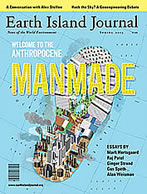Or at least so goes the headline from my chat with Brian Lehrer on WNYC today, encompassing the Anthropocene (and how to pronounce it) as well as our heated future. Take a listen!
Tag: Anthropocene
It’s just human nature…
As you may know, I’m writing a book. It’s on the Anthropocene. As befits any book project, I’m staking out a website. Stay tuned!
The Art of Life in the Anthropocene
THE RED VEINS of a certain pink petunia flower come courtesy of human DNA — the A’s, C’s, T’s, and G’s that teach a cell how to build itself. With the help of a virus, Brazilian-born Eduardo Kac was able to stitch human DNA — his own — into a petunia, veining the flower’s petals in red by generating an antibody with a snippet of his genetic code. This so-called “Edunia” is neither the product of genetic research, per se, nor botanical gamesmanship. Kac is simply an artist, and the Edunia (along with limited edition seed packs) has been exhibited from Minneapolis to Barcelona, a show he calls “Natural History of the Enigma.”
Or, as Kac puts it:
The petal pink background, against which the red veins are seen, is evocative of my own pinkish white skin tone. The result of this molecular manipulation is a bloom that creates the living image of human blood rushing through the veins of a flower.
Such is art in the Anthropocene, this new era of man necessitated by our ever-expanding impacts on the planet as a whole, from geology to biology. Kac’s work is hardly alone. Bio-art in the Anthropocene ranges from a book stored entirely in DNA to a poem “written” by a microbe, a living poem known as “The Xenotext” to its progenitor (not exactly author) Christian Bök of the University of Calgary.
…
Head over to the L.A. Review of Books to read the rest.
Welcome to the Anthropocene: Earth Island Edition
 “As in all things, the bacteria got there first. One tiny cell built inside of itself a new pigment, a brilliant green thanks to its ability to absorb only certain colors in the light of a younger, weaker Sun. The pigment – dubbed chlorophyll by animals that rely on this one cell’s innumerable descendants to power name-giving brains – channeled the energy in sunshine to split the waters of Earth’s early oceans. The cell took in carbon dioxide, paired it with once watery hydrogen, and made food. In the process out bubbled a flammable gas that made life as we know it possible: oxygen.
“As in all things, the bacteria got there first. One tiny cell built inside of itself a new pigment, a brilliant green thanks to its ability to absorb only certain colors in the light of a younger, weaker Sun. The pigment – dubbed chlorophyll by animals that rely on this one cell’s innumerable descendants to power name-giving brains – channeled the energy in sunshine to split the waters of Earth’s early oceans. The cell took in carbon dioxide, paired it with once watery hydrogen, and made food. In the process out bubbled a flammable gas that made life as we know it possible: oxygen.
These bacteria were the first geoengineers – large-scale manipulators of the planetary environment…” And we will be the second. Read the rest over at Earth Island Journal.
Finding Character

So now that I’ve settled on the classic “journey” structure (for the moment), I’m turning my attention to characters. Who’s going to populate this book of mine? And who’s going to keep readers turning pages?
I’ve got folks who could certainly serve: from a buttoned-down astronaut who now spends his time studying how to deploy renewable energy most effectively to a mustachioed oceanographer raised in the Himalayas who would like to use marine life to rejigger the skies. There’s even the man Stephen Colbert asked: “Are you trying to play God, sir? Because you certainly have the beard for it.” (That’d be George Church, who’s also been in the news lately for saying the resurrection of Neanderthals is imminently feasible and possibly desirable.)
The problem is I have no single character who can carry the entire saga of the Anthropocene. My only hope is that I can somehow weave these characters in and out of some over-arching narrative but I’m worried that what will actually happen is that I’ll just write a couple of scenes or set-pieces and then that’s the end of that character for the rest of the book. (Call it seven to 10 articles masquerading as a book, or “journalist’s syndrome.”)
I guess the only way to find out is to start writing…